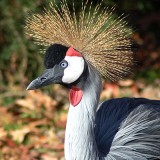CLASSIFICATION
Order: Psittaciformes
Family: Psittacidae
Genus: Anodorhynchus
Species: hyacinthinus
RANGE
Interior of southern Brazil.
HABITAT
Swamps, forests and palm groves.
SIZE
Length: 40 inches (100 cm.)
LIFE EXPECTANCY
30 – 40 years in captivity
REPRODUCTION
- Nests in trees, probably in the trunk of palm trees, or on cliffs.
- Wild pairs have a high rate of failure, only about 15 – 30% of the pairs are believed to breed each year, almost invariably fledging only a single chick.
- As few as 50% of the chicks hatched in the wild survive the first few weeks.
- Those in captivity can produce in one year what the wild hyacinths would breed in their lifetimes.
BEHAVIOR
Using their short, powerful legs and feet, they hang sideways or upside-down while plucking palm nuts from fruit clusters.
DIET
Wild: Palm nuts, snails, salt from bricks laid out for cattle, and earth containing great mineral deposits.
Zoo: Parrot mix, fruits and vegetables
STATUS
Endangered. CITES Appendix I. Currently approximately 2,500 – 5,000 birds are left in the wild. Their decline is due to illegal international trade, local commerce, habitat loss (deforestation) and being shot for food and feathers by native people. Commercial international trade should end, if countries will observe and enforce the trade ban.







